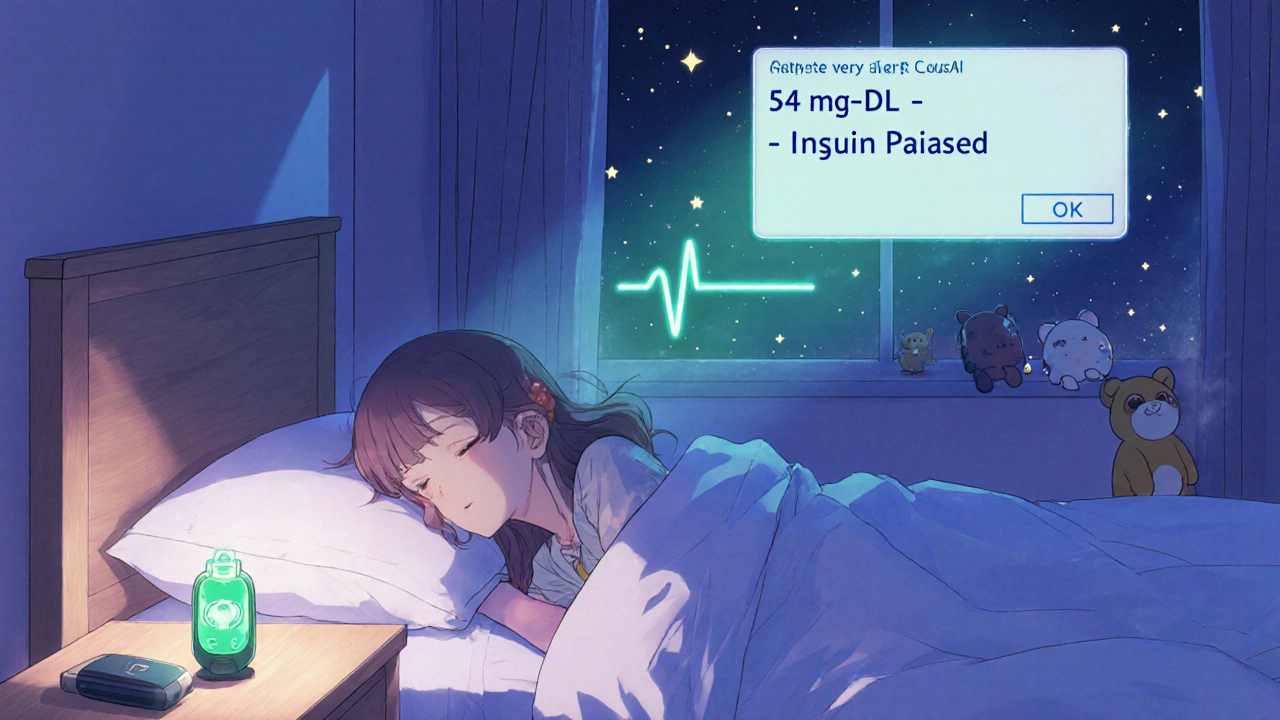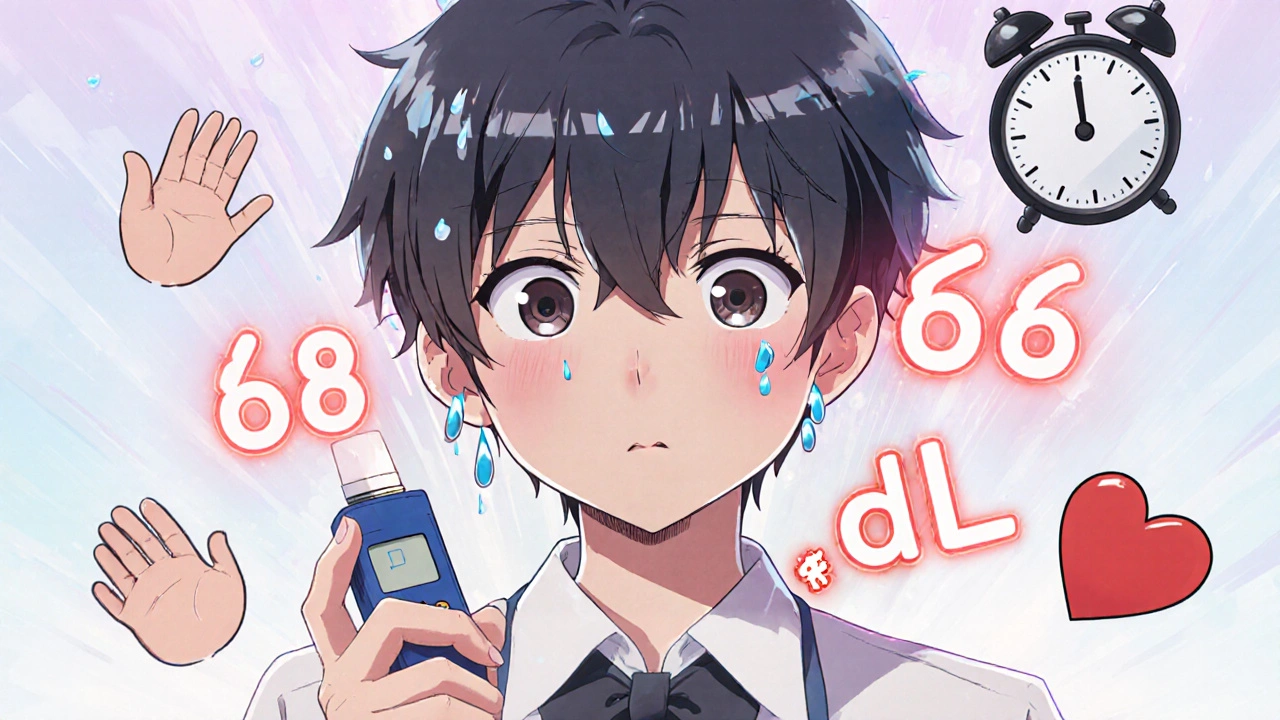What Is Hypoglycemia?
Hypoglycemia is a condition where blood sugar drops below 70 mg/dL (3.9 mmol/L), most commonly affecting people with diabetes who use insulin or certain oral medications. It’s not just a minor inconvenience-it’s a medical event that can lead to confusion, seizures, or even unconsciousness if not treated quickly. Even if you don’t have diabetes, low blood sugar can happen, but it’s far less common. For people managing diabetes, hypoglycemia is the most frequent acute complication. Around 47% of those with Type 1 diabetes and 33% of those with Type 2 diabetes on insulin experience it at least once a year.
How Do You Know You’re Having a Low?
Your body sends signals when blood sugar drops too low. These come in two main types: physical and mental.
- Physical symptoms: Shaking, sweating, rapid heartbeat, hunger, dizziness, and tingling around the mouth. These happen because your body releases adrenaline to try to raise blood sugar. You might feel like you’re having a panic attack-even if you’re calm.
- Mental symptoms: Confusion, trouble speaking, blurred vision, irritability, or feeling like you’re in a fog. These are more dangerous because they can make you unable to treat yourself. At 50 mg/dL or lower, your brain isn’t getting enough fuel. Driving or operating machinery becomes risky-your reaction time is as impaired as if you had a blood alcohol level of 0.08%.
Not everyone feels the same signs. Some people lose warning symptoms over time, especially after years of frequent lows. This is called hypoglycemia unawareness, and it affects about 1 in 4 long-term Type 1 diabetes patients. That’s why checking your blood sugar regularly-even when you feel fine-is critical.
What Causes Low Blood Sugar?
Most hypoglycemia in people with diabetes happens because of a mismatch between medication, food, and activity.
- Too much insulin or diabetes medication: This is the #1 cause. Taking your usual dose but eating less than planned, or injecting too much by accident, can send sugar crashing.
- Skipping or delaying meals: If you take insulin and don’t eat on time, your blood sugar will drop. Even a missed snack can trigger it.
- Exercise without adjustment: Physical activity lowers blood sugar. If you go for a long walk, bike ride, or workout without eating extra carbs or reducing insulin, you’re at risk. High-intensity workouts (over 6 METs) are especially likely to cause lows.
- Alcohol: Drinking, especially on an empty stomach, blocks your liver from releasing stored glucose. This can cause lows hours after drinking-even overnight.
- CGM lag: Some continuous glucose monitors (CGMs) can be 10-20 minutes behind real-time blood sugar. If your glucose is dropping fast, your CGM might still show a normal number while you’re already feeling symptoms.
For people without diabetes, hypoglycemia is rare. When it does happen, it’s often linked to conditions like insulinoma (a rare pancreatic tumor), severe liver or kidney disease, or after weight-loss surgery. Reactive hypoglycemia-low sugar after eating-is sometimes seen after gastric bypass, but it’s uncommon in the general population.

How to Treat a Low Blood Sugar Episode
When your blood sugar is below 70 mg/dL, you need fast-acting sugar-quickly.
- Take 15 grams of fast-acting carbs: This could be 4 glucose tablets, 1/2 cup of fruit juice, 1 tablespoon of honey, or 6-8 hard candies. Avoid chocolate or cookies-they have fat, which slows sugar absorption.
- Wait 15 minutes: Don’t eat more yet. Give your body time to absorb the sugar.
- Check again: If you’re still below 70 mg/dL, repeat the 15 grams. Once you’re above 70, eat a small snack with protein and carbs (like peanut butter on toast) to stabilize it.
This is the 15-15 rule, and it works in about 78% of mild to moderate cases. But if you’re too confused, unconscious, or having a seizure, you can’t treat yourself. That’s when someone else needs to give you glucagon.
Glucagon is a hormone that tells your liver to release stored sugar. It comes as an injection or nasal spray. The nasal version (Dasiglucagon) works in under 15 minutes for 94% of people. It’s now recommended for everyone on insulin to have one at home-and for family, friends, or coworkers to know how to use it.
Preventing Hypoglycemia
Prevention is better than treatment. Here’s how to reduce your risk:
- Check your blood sugar often: Before meals, before bed, and before driving. If you use a CGM, set alerts for when your sugar drops toward 70 mg/dL. Some newer systems can even pause insulin automatically when your sugar is falling too fast.
- Match carbs to insulin: Learn how many grams of carbs your insulin covers. Adjust your dose if you eat less than usual or skip a meal.
- Plan for exercise: Eat 15-30 grams of carbs before activity if your sugar is below 100 mg/dL. Reduce your insulin dose by 20-50% for prolonged workouts. Check sugar during and after exercise-it can drop hours later.
- Never drink alcohol on an empty stomach: Always pair it with food. Avoid drinking before bed unless you’ve eaten enough carbs to cover it.
- Keep emergency glucagon handy: Make sure your partner, kids, or coworkers know where it is and how to use it. Practice with a trainer pen if you have one.
- Wear medical ID: A bracelet or necklace that says “Diabetic” or “Insulin Dependent” can save your life if you’re found unconscious.
Special Considerations: Nighttime and Older Adults
Nighttime lows are one of the biggest fears for people with diabetes. You might not wake up. This is called nocturnal hypoglycemia and affects 76% of Type 1 users. It’s linked to the “dead-in-bed” syndrome-a rare but tragic cause of death in young people with Type 1 diabetes.
Strategies to prevent nighttime lows:
- Check your blood sugar before bed. If it’s below 100 mg/dL, eat a small snack with protein and complex carbs.
- Use a CGM with overnight alerts. Some devices can send alerts to your phone or smartwatch.
- Consider a smart insulin pump with predictive low-glucose suspend. These systems automatically stop insulin delivery when your sugar is predicted to drop below 55 mg/dL. Studies show they cut nighttime lows by 44%.
Older adults often have atypical symptoms-falls, confusion, or dizziness-instead of shaking or sweating. These are easily mistaken for dementia or stroke. In fact, 32% of emergency calls for suspected stroke in older adults turn out to be hypoglycemia. Regular glucose checks and simplified treatment plans are essential for seniors.

What’s New in Hypoglycemia Management?
Technology is changing how we prevent and respond to low blood sugar.
- Glucagon nasal spray: Approved in 2023, it’s easier to use than injections and works just as fast.
- Artificial pancreas systems: Devices like Tandem Control-IQ now automatically adjust insulin based on real-time glucose trends. They reduce time spent below 54 mg/dL by over 3 hours per week.
- Predictive algorithms: Researchers are developing AI tools that can forecast a low up to 45 minutes in advance using glucose data, activity, and meal logs. Early trials show 85% accuracy.
- Glucose-responsive insulin: In Phase 2 trials, this new type of insulin automatically slows down when blood sugar drops-potentially cutting hypoglycemia by over 60%.
These aren’t science fiction-they’re available now or coming soon. If you’re on insulin, talk to your doctor about whether any of these options could help you.
When to Call for Help
Call 911 or go to the ER if:
- You’re unconscious or having a seizure and no one can give you glucagon.
- You’ve had two or more severe lows in a week.
- You’re confused and can’t treat yourself, even after taking carbs.
- Your CGM shows a low, but you don’t feel any symptoms-this could mean you’ve lost awareness.
Don’t wait. A severe low can turn dangerous in minutes. Emergency teams are trained to recognize and treat hypoglycemia fast. If you’re unsure, it’s better to be safe.
Final Thoughts
Hypoglycemia is scary, but it’s manageable. Most episodes are preventable with awareness, planning, and the right tools. You don’t have to live in fear of lows. Learn your triggers. Carry fast-acting sugar. Teach people around you how to help. Use technology to stay ahead of the drop. And never underestimate the power of a simple glucose check.
Low blood sugar doesn’t define you. But how you handle it? That does.
What is the normal blood sugar range for someone with diabetes?
For most people with diabetes, a normal fasting blood sugar is between 80-130 mg/dL before meals, and under 180 mg/dL two hours after eating. But individual targets vary. Your doctor will set your personal goals based on age, health, and type of diabetes. Hypoglycemia is defined as below 70 mg/dL, regardless of your target range.
Can non-diabetics get hypoglycemia?
Yes, but it’s rare. Non-diabetic hypoglycemia usually happens in two forms: reactive (after meals, often after weight-loss surgery) or fasting (due to conditions like insulinoma, liver disease, or hormone imbalances). If you’re not diabetic and keep having low blood sugar, see a doctor to rule out underlying issues.
Why do I feel shaky even when my blood sugar is normal?
If you’ve had frequent lows in the past, your body may start reacting to even small drops-even if your sugar is still in the normal range. This is called a false low. Over time, your body can re-adjust. But if you’re consistently feeling symptoms at higher levels, check with your care team. You might need to raise your target range slightly to rebuild awareness.
Does stress cause low blood sugar?
Stress usually raises blood sugar, not lowers it. But if stress causes you to skip meals, forget insulin, or over-exercise, it can indirectly lead to a low. Also, stress can make you more sensitive to the symptoms of hypoglycemia, so you might feel worse even if your sugar isn’t dangerously low.
How long does it take to recover from a low blood sugar episode?
Most people feel better within 10-15 minutes after taking 15 grams of fast-acting carbs. Full recovery-especially mental clarity-can take up to an hour. Don’t drive or return to work until you feel completely back to normal. A second check 30-60 minutes later helps ensure your sugar is stable.
Can I prevent nighttime lows without waking up?
Yes. Using a CGM with predictive alerts and a smart insulin pump that automatically suspends insulin when your sugar is falling can help. Setting a slightly higher bedtime target (like 110-120 mg/dL) and avoiding alcohol or intense exercise late in the day also helps. Many people find they sleep better once they stop waking up from hypos.


Rachel Puno
November 10, 2025 AT 14:47Steve Phillips
November 10, 2025 AT 23:50Brad Seymour
November 12, 2025 AT 04:55Malia Blom
November 13, 2025 AT 04:01Erika Puhan
November 14, 2025 AT 08:01Cris Ceceris
November 14, 2025 AT 09:49Clyde Verdin Jr
November 16, 2025 AT 06:37Key Davis
November 16, 2025 AT 11:26Lexi Brinkley
November 18, 2025 AT 10:09Edward Weaver
November 20, 2025 AT 04:23